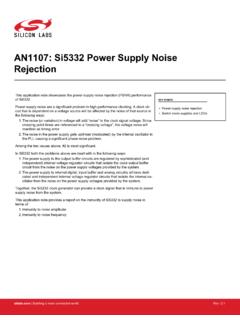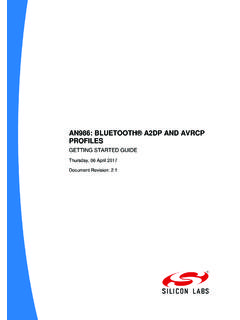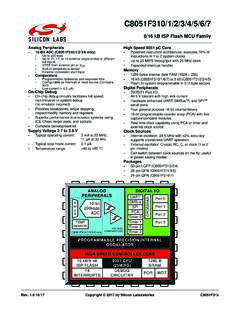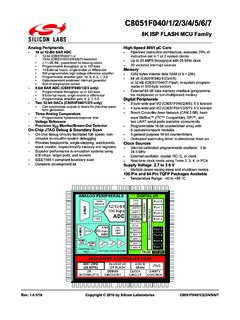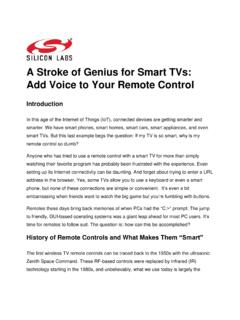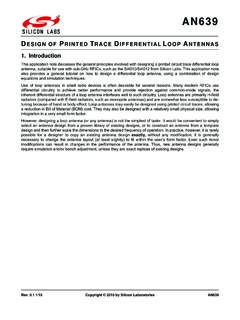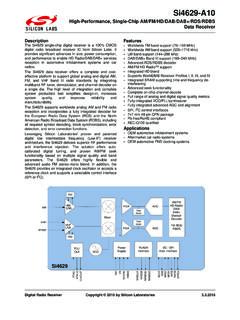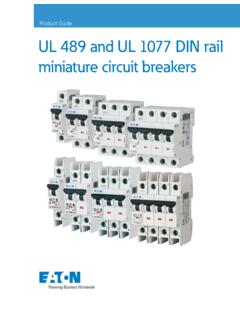Transcription of AN958: Debugging and Programming Interfaces for Custom …
1 AN958: Debugging and ProgrammingInterfaces for Custom DesignsThe Silicon Labs MCU and Wireless Starter Kits and SimplicityStudio provide a powerful development and debug order to take advantage of these capabilities and features on Custom hardware, Sili-con Labs recommends including Debugging and Programming interface connector(s) incustom hardware designs. Possible options include full support of all Debugging andprogramming capabilities of the STK, to serial wire Programming only. This applicationnote describes the benefits of including these connector Interfaces in Custom hardwaredesigns and provides the details regarding these POINTS Wireless starter kits along with SimplicityStudio provide a powerful developmentand debug environment Use the Debugging and programminginterface connector(s) to take advantage ofthese capabilitiesSimplicity Debug Adapter | Building a more connected 1.
2 Device CompatibilityThis application note supports multiple device families, and some functionality is different depending on the device. 32-bit MCUs 8-bit MCUs 32-bit Wireless MCUs 32-bit Wireless Gecko ModulesAN958: Debugging and Programming Interfaces for Custom DesignsDevice | Building a more connected | 22. BackgroundThe Silicon Labs MCU Starter Kit (STK) and Wireless Starter Kit (WSTK) provide a powerful development and debug environmentwhen used with Simplicity Studio. The STK and WSTK provide several debug capabilities and features, including the following: SWD (serial wire debug) 2-pin serial wire debug interface for Programming and Debugging , using the pins SWCLK and SWDIO. JTAG 4-wire interface for Programming and Debugging , using the pins TCK, TMS, TDI, and TDO. C2 interface (for 8-bit devices) 2-wire Programming interface used by most Silicon Labs 8-bit MCUs.
3 See "AN124: Pin Sharing Techniques for the C2 Interface", which discusses pin sharing for C2 devices. ETM* (embedded trace macrocell) Debug component which enables reconstruction of program execution, and is designed as a high-speed, low-power debug toolthat only supports instruction trace. AEM (advanced energy monitoring) Accurate high-speed current measurements and energy Debugging /profiling when the STK/WSTK power selection switch is in theAEM position. Use with Simplicity Studio Energy Profiler perspective. PTI (packet trace interface [WSTK only]) Physical layer (PHY) level PTI for effective network-level Debugging . Monitors all the PHY transmit and receive packets betweenthe MAC and baseband modules within the radio without affecting normal operation. VCOM (virtual COM port) UART COM port interface to the target from the debugger (pass-through UART).
4 Virtual UART SWD-based virtual UART interface to the target from the debugger, available through the SWD interface (SWDIO, SWCLK, andSWO).These features are available via several different interface means, depending on the features required by the Custom target hardwaredesign and the board space available for these interface connectors or test points. These details are discussed in the following STK and WSTK support ETM only when using an external debugger which supports ETM Capture. The STK and WSTK donot include an ETM capture unit. Only devices that have an ETM macrocell will support ETM capture, regardless of the debuggercapabilities. Consult the corresponding MCU or Wireless device data sheet for details regarding whether ETM is supported on thedevice. Silicon Labs MCU and Wireless Development Kits may include support for ETM.
5 Consult the kit documentation for ensure that the STK and WSTK properly recognize the connected target device, go to the target adapter in the "Debug Adapt-ers" list in Simplicity Studio, right-click on the target adapter, select "Device Configuration", select the "Device Hardware" tab, andenter the full part number of the external device target under "Target Part". AN958: Debugging and Programming Interfaces for Custom | Building a more connected | 33. Interface Feature MappingThe table below summarizes the capabilities and features of the various Interfaces described in the following sections. Click on the col-umn header hyperlinks to go directly to the section describing each specific Interface Capabilities and FeaturesFeature20-pin StandardARM CortexDebug+ETMC onnector20-pinSimplicityConnectorSimplic ity Debug Adapter Board Interfaces (Standard or Tag-Connect 10-pin cable)Tag-Connect6-pinInterfaceMiniSimpl icityConnectorCortex DebugConnectorISA3 PacketTrace PortConnectorSWD (serial wire debug)XXXXXJTAGXXXC2 XXETM (embedded tracemodule)XAEM (advanced energymonitoring)XXPTI (packet trace interface)XXXVCOM (virtual COM port)XXVirtual UARTXXXXXAN958: Debugging and Programming Interfaces for Custom DesignsInterface Feature | Building a more connected | 44.
6 Connector InterfacesThis section presents the standard debug connector Interfaces provided by the STK and WSTK, as well as recommendations for includ-ing connector Interfaces on Custom target hardware designs in order to utilize these debug capabilities and Standard ARM Cortex Debug+ETM ConnectorIn cases where ETM and/or JTAG debug capabilities and features are required on Custom target hardware, a 20-pin (2x10, mmpitch) standard ARM Cortex Debug+ETM Connector (similar to Sullins part number GRPB102 VWQS) should be included in the de-sign. A 20-pin 2x10 mm pitch ribbon cable (similar to Samtec part number ) is required for the connectionbetween the WSTK debug connector and the Custom target hardware board : Silicon Labs deviates slightly from the ARM standard, as this version of the connector includes the key pin.
7 Connector Pin-OutA pin-out for this debug connector interface is provided in the figure and table below. If ETM and/or JTAG are not required, see5. Alternative Interfaces for other debug interface options to include on target hardware / SWDIO / C2 DTCK / SWCLK / C2 CKTDO / SWOTDI / C2 DpsTRACECLKTRACED0 TRACED1 TRACED2 TRACED3 RESET / C2 CKpsGNDNCNCGNDGNDGND7 GNDVTARGETC able DetectNCFigure Debug ConnectorAN958: Debugging and Programming Interfaces for Custom DesignsConnector | Building a more connected | 5 Table Debug Connector Pin DescriptionsPin Number(s)FunctionNote1 VTARGETR eference voltage on the target application. Used for shifting logical signallevels between target and / SDWIO / C2 DJTAG test mode select, Serial Wire data or C2 data4 TCK / SWCLK / C2 CKJTAG test clock, Serial Wire clock or C2 clock6 TDO/SWOJTAG test data out or Serial Wire Output8 TDI / C2 DpsJTAG test data in, or C2D "pin sharing" function110 RESET / C2 CKpsTarget device reset, or C2CK "pin sharing" function12 TRACECLKNot connected14 TRACED0 Not connected16 TRACED1 Not connected18 TRACED2 Not connected20 TRACED3 Not connected9 Cable detectConnect to ground11, 13 NCNot connected3, 5, 15, 17, 19 "AN124: Pin Sharing Techniques for the C2 Interface", which discusses pin sharing for C2 Connector FootprintAn example component footprint is from Sullins for part number GRPB102 VWQS.
8 Refer to for details on this connector footprint for the Custom target hardware 20-pin Simplicity ConnectorIf AEM, PTI, and VCOM functionality are desired, include the 20-pin (2x10, mm pitch) Simplicity Connector (similar to Sullins partnumber GRPB102 VWQS) on the target hardware design. A 20-pin 2 x 10 mm pitch ribbon cable (similar to Samtec part ) is required for this connection between WSTK Simplicity connector and the Custom target hardware board con-nector. If space constraints do not allow inclusion of this connector on the target hardware design, see 5. Alternative Interfaces forsmaller Interfaces which provide similar debug : Debugging and Programming Interfaces for Custom DesignsConnector | Building a more connected | Connector Pin-OutA pin-out for this Simplicity Connector interface is provided in the figure and table ID SCL19 Board ID SDA2 Virtual COM TX / MOSI4 Virtual COM RX / MISO6 Virtual COM CTS / SCLK8 Virtual COM RTS / CS10 Packet Trace 0 Sync12 Packet Trace 0 Data14 Packet Trace 0 Clock16 Packet Trace 1 Sync18 Packet Trace 1 Data20 Packet Trace 1 ClockFigure Simplicity ConnectorTable Simplicity Connector Pin DescriptionsPin Number(s)
9 V power rail , monitored by the V power rail55V5 V power rail2 VCOM_TX_MOSIV irtual COM Tx/MOSI4 VCOM_RX_MISOV irtual COM Rx/MISO6 VCOM_CTS_#SCLKV irtual COM CTS/SCLK8 VCOM_#RTS_#CSVirtual COM RTS/CS10 PTI0_SYNCP acket Trace 0 Sync12 PTI0_DATAP acket Trace 0 Data14 PTI0_CLKP acket Trace 0 Clock16 PTI1_SYNCP acket Trace 1 Sync18 PTI1_DATAP acket Trace 1 Data20 PTI1_CLKP acket Trace 1 Clock17 EXT_ID_SCLB oard ID SCL19 EXT_ID_SDAB oard ID SDA7, 9, 11, 13, 15 GNDNote: Packet Trace 0 should be the default packet trace port selection. Packet Trace 1 is reserved for implementations which includemore than one radio on the same IC. Connector FootprintAn example component footprint is from Sullins for part number GRPB102 VWQS. Refer to for details on this connector footprint for the Custom target hardware : Debugging and Programming Interfaces for Custom DesignsConnector | Building a more connected | 75.
10 Alternative InterfacesIn addition to the standard connector Interfaces provided with the STK and WSTK, there are some alternative Interfaces that are availa-ble, depending on debug needs and available space. The following sections outline these alternative Simplicity Debug Adapter Board InterfacesThe Simplicity Debug Adapter Board, when plugged into the two 20-pin connectors of the STK or WSTK, remaps these Interfaces toprovide a sub-set of debug capabilities and features through a smaller form-factor connector interface. The Simplicity Debug AdapterBoard is available standalone with a 15 cm (6 inch) cable as orderable part number space constrained designs, Silicon Labs recommends the Mini-Simplicity Connector, a 10-pin (2 5) small form-factor ( mmpitch, mm pin length) header connector (similar to Samtec part number FTSH-105-01-L-DV-K), on the Custom hardware will mate with the standard 10-pin ribbon cable (Samtec part number ) included in the SLSDA001A kit, con-necting to the Mini Simplicity Interface Connector on the Simplicity Debug Adapter Board.
